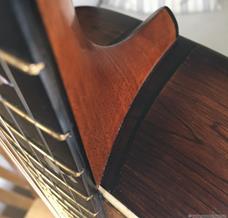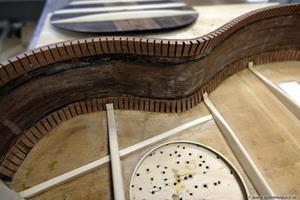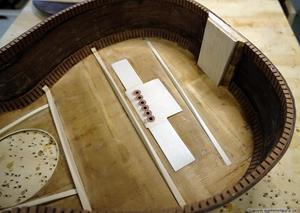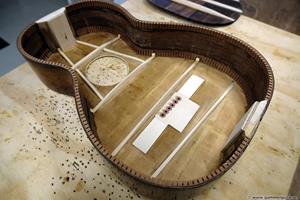After a break in production to help Farre with his guitars, it's back to the Old Gura batch. Expect to have one done a week, the first one is already finished and the others should get the bottom and neck glued.
A guitar stands out in the batch, a George Bauer from around 1890. In its time a very fine and lavish instrument. George built guitars in Philadelphia, USA between about 1890-1910. Have had the privilege of working with three Bauer guitars and all have been well-built, light and with an abundance of beautiful wood, bindings and mother-of-pearl inlays. All have also had thin about 2,3-2,5 mm spruce lids with slight ribs and long mensur. All indications are that they were made for tendon strings. You can not complain about the craftsmanship, very beautifully shaped stables and all dimensions and thicknesses except maybe the lid is just as they should be.
The guitar looked to be in very good condition, but when I inspected it more closely it was not so. My guess is that the guitar was exposed to high heat and the built-in spring tension from the sides had basically "blown" the guitar in all the joints between the lid / bottom and side. Someone had done their best to glue the lid and bottom together to the side and also applied a thin layer of modern varnish over the entire guitar. The ribbing in this was a slight ladder bracing
A great mystery was also that the sides were joined with two approximately 2 cm wide black-stained pieces of wood on both sides of the neck foot. The extra joints were not made with the same craftsmanship as the rest of the guitar. Even the other end of the sides at the end plug did not seem to fit together properly. Cracks in joints had been filled with some kind of pulp similar to plastic padding. It turned out that the side was made of a relatively thick three-layer plywood and not solid BRW as the bottom. Plywood was not completely unknown around 1900, but not common and the other Bauer I have seen have solid wood. I have never encountered anything like this!
Missed taking pictures of the original, here are some pictures from the work on the guitar. You can clearly see that the page is in three layers, probably mahogany between two BRW veneers. Replaced the clumsy black-stained wood piece with an ebony strip in the joint and a piece of matching rosewood.
One possible explanation is that the page comes from another guitar that was not quite the same size and did not have exactly the right shape but which was forced into place and joined. What is the truth we will never know, the positive is that the plywood sides match the bottom of BRW very well.
The customer wanted to make it playable and sound as good as possible, which meant that everything included in an GammelGura was done. No K&K mic and no guitar strap knob on the neck foot. It is a slightly larger parlor with a long menstrual cycle. The relatively high weight is due to the extra thick side.
- Total length: 95,5 cm
- Top (upper round, waist, lower round): 23,2 - 19 - 32,7 cm
- Side (neck block, waist, end block): 8,8 - 9,4 - 9,1 cm
- Neck: Weak V-shape
- Upper saddle: 47 mm
- 12th band: 53 mm
- String length: 65 cm
- Paint: Spray
- Weight: 1442 g
The bottom had two stamps, a regular George Bauer burn stamp from the manufacture but also a weak ink stamp. As far as I could tell it says "FA Rankin / Music dealer Eugene ORE". The guitar must have been privately owned by the Rankin family according to the seller. Most likely, they put the stamp for sale there, but chose to keep it. Found some info online: “Francis Albert Rankin
(14 April 1852 - 10 Apr 1925) FA Rankin had photography studio in Eugene, OR, from about 1874 until February of 1893 when he sold the business to Catterlin and Hicks. He was in the musical instrument business for the rest of his life."Indicates that the guitar is not older than 1893.
The seller of the guitar writes: “I bought the Bauer in Portland, Oregon from a gentleman who might have been a descendant of Mr. Rankin. The gentleman told me that the guitar had been "in the family" as long as he could remember. I do not know who, in the family, might have visited the indiscretions upon the guitar. The transaction took place in 2008. ”.
Getting rid of the neck was easy as it has the same attachment as a Levin parlor, no real dovetail. The beautifully worked stable with curved top was in fine ebony, but too narrow to accommodate a toned and segmented stable leg, so a replica was made. The replica was probably the nicest stall I ever made, so this is what my future pyarmid stalls will look like 🙂


The grip board was also in fine ebony, but very thin. Only about 3 mm thick which was a common design before realizing that the joint between the neck and the lid needs a thicker and more stable board on top so as not to succumb to the string. Also wanted to give the board a slightly larger radius. The solution was to glue a roughly as thick shim under the original board with warm skin glue. The straps actually sat almost exactly right, so I didn't have to fill in the grooves and cut for the straps. The grinding of the radius took place most along the edges and the pearl pieces in the intricate inserts were thick enough to be able to be ground flat.
The tuning screws were replaced with slightly finer Golden Age tuning screws from Stewmac. With 12 metal bushings for the posts, they felt almost luxuriously tight when I was done.
Took too little pictures of the most difficult part of the renovation. In normal cases I just remove the bottom, but now I had to remove both the lid and the bottom from the side halves. The necklace must also be loosened. When the pages were free, they burst out and nothing matched anymore. To get some sort of order on the whole, I used the almost completely crack-free lid as a template and started by gluing the sides to the lid. Used a jig where I could force the side together so it followed the shape of the lid, in the jig I could force the side both inwards and outwards with forcing. When the lid was glued to the side, I turned the guitar body and glued the carving around.
The next step was to glue the notch to the bottom, still in the same jig shaped after the lid shape.
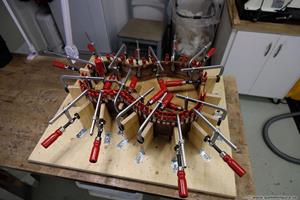
The last step was to glue the necklace in place.

The joints on both sides of the neck foot were glued. The joints at the other end of the sides were adorned with moldings of ebony instead of wood pulp.
To get loose the bottom I had to sacrifice the binding in rosewood and decor moldings in rosewood and maple. The bottom did not fit very well with the new shape from the lid, but it was possible to mill around and paste both decorative moldings and an outer binding in rosewood.
New ribs were glued in the lid and the bottom, here are pictures from the bottom gluing. Used weights to ensure that the body would not be twisted after all previous sutures. Both the neck and the bottom block were reinforced with a thin plate in birch plywood.
The upper saddle in legs, stables and stable legs was manufactured and mounted. The grip board was glued, ground planed and got new straps. The thin modern lacquer was sanded away on both neck, side and bottom. The varnish of the lid was roughened with steel wool. Then the whole guitar was lacquered with a couple of turns of liquor lacquer, liquor lacquer adheres well to almost anything. The neck pocket had a maple plate glued to the bottom and a wooden screw was pulled into the neck foot from the inside to secure the weak neck attachment.
When I string it up with NH 0.12 it didn't feel good with the thin lid and the long men's watch. Tried first with NH 0.11 which works, but finally decided to glue a fir patch in the middle of the lid, as wide as the width of the strings between the first and second bars under the sound hole, to make the lid stronger. It worked well, if something happened to the sound it was just positive. It became a little more focused and not as flabby and hollow in tone as it might otherwise be with a thin lid.
So how does it sound? Probably it is the Old Gura that sounds best so far! Very similar to my own Levin parlor in the tone, but what sets it apart is how easily driven it is. It is almost difficult to play it quietly, the notes throw themselves out of the guitar only when you click on the strings 🙂 A very nice reward after all the extra work!





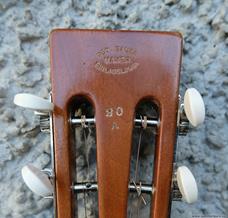



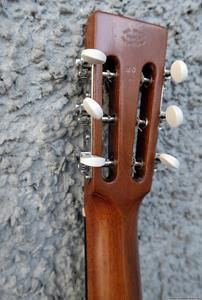
Here's one catalog of Bauer guitars.
Must share with me some of what the buyer / owner from the US writes about it!
"You have of course eclipsed all possible expectations and wildest wishes with your transformation of the Bauer from an ugly duckling to a gorgeous swan - and a swan that sounds like a symphony of richness, depth, and overtones. To say that I am thrilled with it does not start to convey my appreciation. It has instantly become my favorite guitar of all time - and I possess many, and have played many more, as you well know. It is the ne plus ultra, “holy grail” instrument that I have been searching for: for looks, sound, feel, and playability."


